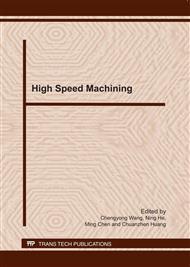[1]
C. Chen, K-H. Fuh, The cutting performance of a TiN-coated drill with curved primary cutting edges, Journal of Material Process Technology. 49(1995) 183–198.
DOI: 10.1016/0924-0136(94)01326-v
Google Scholar
[2]
T. Hoshi, H. Zhao, Study of a high performance drill geometry, Annals. CIRP 38 (1) (1989) 87–90.
DOI: 10.1016/s0007-8506(07)62657-2
Google Scholar
[3]
E.O. Ezugwu, C.J. Lai, Failure modes and wear mechanisms of M35 high-speed steel drills when machining inconel 901, Journal of Material Process Technology. 49 (1995) 295–312.
DOI: 10.1016/0924-0136(94)01352-2
Google Scholar
[4]
Viorel Petrariu, Dumitru Amarandei, Stelian Alaci, Study about finite element analysis of high speed drilling, Fascicle of Management and Technological Engineer, 7(17)(2008) 1685-1689.
Google Scholar
[5]
K. Adachi, N. Arai, K. Okita, K. Ogawa, R. Niba, A study on drilling of SUS304 by TiN-coated drills, Bulletin Japan Society of Precision Engineering Bull. 24 (3)(1990) 200–205.
Google Scholar
[6]
Tsann-Song Lin, Cutting behavior of a TiN-coated carbide drill with curved cutting edges during the high-speed machining of stainless steel, Journal of Material Process Technology. 127(2002) 8-16.
DOI: 10.1016/s0924-0136(02)00073-0
Google Scholar
[7]
T. D. Marusich and M. Ortiz, Modeling and simulation of high-speed machining, International Journal for numerical methods in engineering, 38(1995) 3675-3694.
DOI: 10.1002/nme.1620382108
Google Scholar
[8]
Z. Xu, Y. Li, Dynamic behaviors of 0Cr18Ni10Ti stainless steel welded joints at elevated temperatures and high strain rates, Mechanics of Materials, 41(2009) 121-130.
DOI: 10.1016/j.mechmat.2008.10.005
Google Scholar
[9]
E.M. Trent, Metal cutting, Butterwort, London, (2000).
Google Scholar
[10]
J. Lorentzon, N. Jarvstrat, Modeling the influence of carbides on tool wear, Computational Materials Science and Surface Engineering, 1(2009) 27-37.
Google Scholar
[11]
Yong Huang, Y. Kevin Chou. Steven Y. Liang, CBN tool wear in hard turning: a survey on research progresses, Adv Manuf Technol, 33(2007) 443-453.
DOI: 10.1007/s00170-006-0737-6
Google Scholar
[12]
Lijing Xie, Estinmation of the two-dimension tool wear based on finite element method, Werkzeugmaschinen und Betriebstechnik (WBK), Uni-Karlsruhe (TH), Germany, (2004).
Google Scholar
[13]
T. R. Lin, R. F. Shyu, Improvement of Tool Life and Exit Burr using Variable Feeds when Drilling Stainless Steel with Coated Drills, Adv Manuf Technol, 16(2000) 308-313.
DOI: 10.1007/s001700050162
Google Scholar


